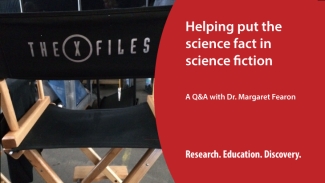Sharing the News: Science Communication for … Scientists
Wednesday, December 21, 2016 Amanda Maxwell
Communicating science is an important part of the job for anyone involved in clinical research, whether it takes place face-to-face with the patient, a donor or the wider scientific community. Unfortunately, outreach like this can seem a daunting prospect to the lab scientist and practitioner; it is often easier to hide behind the bench or the stethoscope.

So how do you get the message out? Being an expert in a subject is not much use if no one knows what you’re working on, and publication in peer-reviewed journals only reaches your peers unless a national newspaper picks it up. Unless you’re active in the conference circuit or you're the first stop for your local news media, most researchers face limited exposure.
Luckily, there is a way, and it’s not too complicated. Our post below should help get you started over the festive break.
“One survey of scientists found that nearly half of all academic scientists were engaged in some type of outreach and interactions with mainstream media have become a standard expectation…” From McClain C and Neeley L. 2014
Science in 140 characters?
Social media, especially Twitter, is an excellent way to reach out. Yes, it is possible to get the story out, even in 140 characters. Scientists tweet about anything and everything, including primary research paper publication, news and opinion, jobs, meetings, experiments that go wrong and of course, what they had for breakfast! To get you started, we’ve rounded up some great resources as a holiday reading list below — why not check some of them out for hints and tips on the art of science communication?
Why take the plunge?
First up – what are the benefits? While it might not bump up your citation rate in journals, taking your research to Twitter gets it in front of a wider audience. In addition to forcing you to be brief (maximum 140 characters!), you'll need to ditch the jargon to make your message accessible. It is a great training in science communication for all levels.
- Networking – Broaden your network among peers, a wider scientific community and curious minds. Also, Yoohoo! local journalists - Guidelines for scientists on communicating with the media from the Social Issues Research Center.
- Clarity – This is your chance to get the correct story out on your research, or even to clear up misinformation and fight clickbait.
- Thinking outside the box – reaching a wider audience works both ways; exposure to new subjects could foster some excellent interdisciplinary collaborations as well as give a different angle on your current research.
- Staying current – with so many researchers and practitioners using social media, it’s a great resource to keep up-to-date within your field.
- Vanquishing stereotypes! – your chance to defeat the uncommunicative scientist image and give researchers an image make-over.
Nuts and Bolts
Interested? Then let’s get started. The links below give handy hints and tips for beginners.
- Science Magazine has a useful How To Use Social Media for Science post to help scientists.
- Paige Jarreau @fromthelabbench, biological engineer turned science communicator, created this handy slideshare and also wrote this post showing how she got started
- Dr. Navneet Majhail explains more on why twitter is useful for health professionals in hematology in the slideshare below:
- Dr. Mike Thompson shares his thoughts in a #EBMT16 (European Society for Blood and Bone Marrow Transplantation) presentation: Social Media in Hematology / Oncology / BMT
- If you like the academic approach, check out this paper from PLoS One, How Are Scientists Using Social Media in the Workplace? Written by three seasoned science communicators, one of whom — marine biologist, David Shiffman — tweets engagingly on ocean life as @WhySharksMatter
- Or maybe, thinking well outside the box, a plant scientist can help? The value and use of social media as communication tool in the plant sciences
- Still need convincing? The Pew Research Center report might persuade you with How Scientists Engage the Public
- Sarah Boon, a seasoned science communicator explains more in What is This Social Media You Speak Of?
And to round things off, the American Association for the Advancement of Science (AAAS) has a handy primer on communicating science online. You may want to bookmark this site for further resources.
Getting Started
Sometimes the best education is to watch and learn; here are just a few Tweeps to follow:
@bloodbankguy (Joe Chaffin, MD), a pathologist and transfusion medicine specialist, tweets regularly. Tweets feature transfusion medicine content on his website, which includes quizzes, podcasts and blog posts on multiple areas of transfusion medicine and blood banking.
@KatePendry, who is a Clinical Director in Patient Blood Management, and NHS Blood and Transplant, for the United Kingdom’s National Health Service (NHS) as well as a Consultant Haematologist, tweets a wide spectrum of blood-related content. She often shares content from other clinical researchers in the field.
@TransfusionWM (Dr. Suzy Morton), also in NHS Blood and Transplant work, regularly shares current research in transfusion medicine.
@Gogmum (Dr. Sylvia Benjamin) is a senior lecturer at Oxford University who tweets about blood, sharing most recently coverage of the American Society of Hematology #ASH16 conference.
@TeamHaem is an educational group from Newcastle-upon-Tyne in the UK, with a number of individuals collectively tweeting out educational resources and updates. It is also a great aggregation of useful resources.
@Frank_Dor is a transplant surgeon at Hammersmith Hospital in London, UK who shares science and research updates while maintaining an active network among the transplantation social media community.
@CaulfieldTim is a professor of health law and science policy at the University of Alberta.
@JeannieCallum is a Canadian expert in transfusion reactions and director of the blood and tissue bank at Sunnybrook Health Sciences Centre.
@dryulialin is a transfusion medicine physician and hematologist. She tweets about transfusion quality improvement, physician education and patient blood management.
@ESaidenberg is a hematologist at The Ottawa Hospital.
Many national and international organizations involved in hematology, transfusion medicine and transplantation science run active social media accounts. Many of them share as-it-happens conference news, which is a boon if you cannot attend, as well as recent research, member education opportunities and other information that is useful to hematology and transplantation professionals.
@ASH_hematology The American Society of Hematology tweets out research as well as promoting journal articles from @BloodJournal
@BritSocHaem The British Society of Haematology, whose website also contains a library of useful diagnostic images
@CanadasLifeline Canadian Blood Services tweets out mainly donor updates, but does include research news and transfusion medicine information in its twitter stream.
@redcrossbloodau The Australian Red Cross’s blood ‘arm’ tweets out donor news and transfusion research.
@TransfusionLib is the social media account of the Transfusion Evidence Library, a digital repository of evidence-based information on transfusion research. The website is supported by the UK Blood Services and contains a fully searchable aggregation of reviews; content is endorsed by the Cochrane Collaboration.
@TransplantJrnl shares updates and research published in Transplantation.
@transplantev is a Centre for Evidence in Transplantation based in the UK, sharing research news, matters of interest and updates for the transplantation community.
@CNTRP Canadian National Transplant Research Program platform to improve donation; extend the longevity of grafts; and improve survival and quality of life for transplant patients.
Hashtagged?
The hashtag is a powerful symbol, and on social media, it’s a great way of directing your news or finding content. For transfusion and transplantation medicine, the following hashtags are the ones to follow and of course, to tag your tweets once you get started. Check out this handy reference to find more healthcare-related content.
#blooducation, #transfusion, #bloodsci, #hematology, #Haematology, #transplantation, #organdonation
Get tweeting!
Hiding behind the bench or the stethoscope is no longer an option for scientists these days. In addition to sharing the knowledge within our own research communities, we also need to encourage public interest. Not only is outreach a great tool for reaching potential transplantation and transfusion donors, a well-educated public is also able to make informed choices on personal medical issues and influence broader policy decisions. Now more than ever, it is important to get out into the world and talk about your work—preferably without a cloud of jargon to get in the way.
What’s stopping you? Get tweeting!
Canadian Blood Services – Driving world-class innovation
Through discovery, development and applied research, Canadian Blood Services drives world-class innovation in blood transfusion, cellular therapy and transplantation—bringing clarity and insight to an increasingly complex healthcare future. Our dedicated research team and extended network of partners engage in exploratory and applied research to create new knowledge, inform and enhance best practices, contribute to the development of new services and technologies, and build capacity through training and collaboration.
The opinions reflected in this post are those of the author and do not necessarily reflect the opinions of Canadian Blood Services nor do they reflect the views of Health Canada or any other funding agency.
Related blog posts
One of our own medical experts helped bring believability to the newest season of The X-Files.
“It’s a Canadian tradition to push blood as far forward as possible in the safest possible way.” There’s a long, rich history of military blood transfusion and Canadians have been at the front and centre of this field since WWI. Getting blood where it’s most needed is a challenge at the best of...

